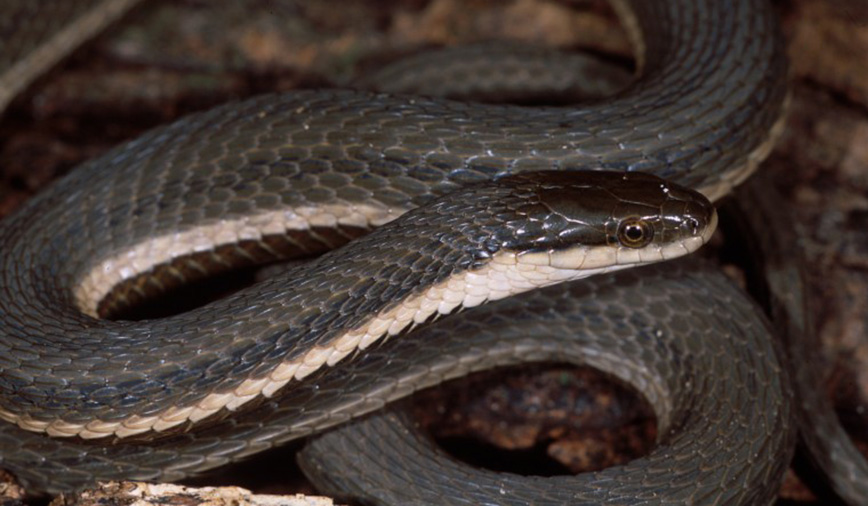Pam’s Perspective
From the…
Pam Otto is the Manager of Natural Programs and Interpretive Services for the St. Charles Park District
July 12, 2012
Except for one time, 25 years ago, when I found myself eating ice cream in a supermarket with Prince Andrew and his then-wife Sarah, the Duchess of York, my brushes with royalty have been as rare as robin’s teeth. Let’s face it; we just don’t have that many crowned heads running around our fair TriCities.
So imagine my surprise a few weeks ago when I—and about a dozen second- and third-graders—came face to face with a real live queen: Regina septemvittata, or queen snake.
No tiara, no scepter, not even a robe…this queen was curled up on a rock in Ferson Creek, not far from the picnic pavilion at Ferson Creek Park in St. Charles.
With all the commotion of the day—50 or so park district nature campers and staff splashing around in celebration of their Creek Day—it seemed odd that the snake would be positioned in such a prominent spot. In fact, for a moment I wondered if it was dead. But as I slowly waded toward it I saw the reason for its nonchalance.
It was getting ready to shed.
If you’ve ever observed a snake in this condition, you’ll know that its eyes take on a hazy, whitish appearance. For an animal whose eyesight is poor at best, this clouding makes it almost impossible to see anything. But as I moved closer, I could detect a distinct change in the snake’s demeanor. It stiffened up ever so slightly, and its tongue began flicking, tasting the air to gain some sense of its surroundings.
It may not have had good eyesight, but I could see that it could “see” me.
Tottering along as I was, in water up to my knees, on a creek bed of silty rocks and broken concrete, I wasn’t really sure who was going to submerge first—me or the almost blind snake. It turns out it was the snake, but only because I found a branch to grab and stabilize myself. With one hand thus occupied, I reached underwater with the other and came up with a decidedly agitated queen.
Agitated, but not uncontrollable. Among snakes that live near water , queens actually are relatively mild mannered. Eschewing the bite-bite-bite-then-bite-some-more defensive strategy of their cousins the Nerodia, or water snakes, queen snakes use the more subtle, but equally effective, tactic of squirming about while ejecting feces and musk.
This queen excelled at all three, for about a minute. Then it calmed down and let us all have a nice, close look.
Adult queen snakes are predominantly olive green and have two prominent yellow stripes, one on either side of their body. The underside is light in color, with two dark stripes running down the middle and two more on either side of the belly.
Math aficionados will notice that the sum of those stripes is six. Yet Latin aficionados, and I know you’re out there, will point out that the queen’s species name, septemvittata, would indicate that seven stripes are present. What gives?
As it turns out, young queen snakes (which are not called princesses) have a seventh stripe present along the middle of the back. This stripe fades with age, though, and is gone completely by the time the queen matures.
Despite the feminine-sounding name, queen snakes come in both male and female varieties. I didn’t do a whole lot of checking that day, but I suspect the Ferson Creek queen was a male. Its lean physique and long tail (for its body length) were what I based that assumption on, but to be completely sure we’d have had to do a much more comprehensive examination. And I don’t think either the snake or I was up to that task.
Gender aside, what was very notable about this snake was its relative rarity in Kane County. In the field guide Amphibians and Reptiles of Illinois, author Chris Phillips notes that the queen snake is considered uncommon across most of its range, but locally abundant where habitat is good.
Interestingly, queens are one of only a few snake species that specialize in consuming freshly molted crayfish. Knowing that, can you now guess what other animal the nature camp kids were finding in Ferson Creek that day?
Yep, crayfish. Lots and lots of ’em. That many were the invasive rusty crayfish is a little sobering, yes, but the fact that a relatively rare species of snake was present, and possibly eating the fiendish rusties, is heartening. It’s also proof that, even in the far western suburbs, it can be good to be queen.

